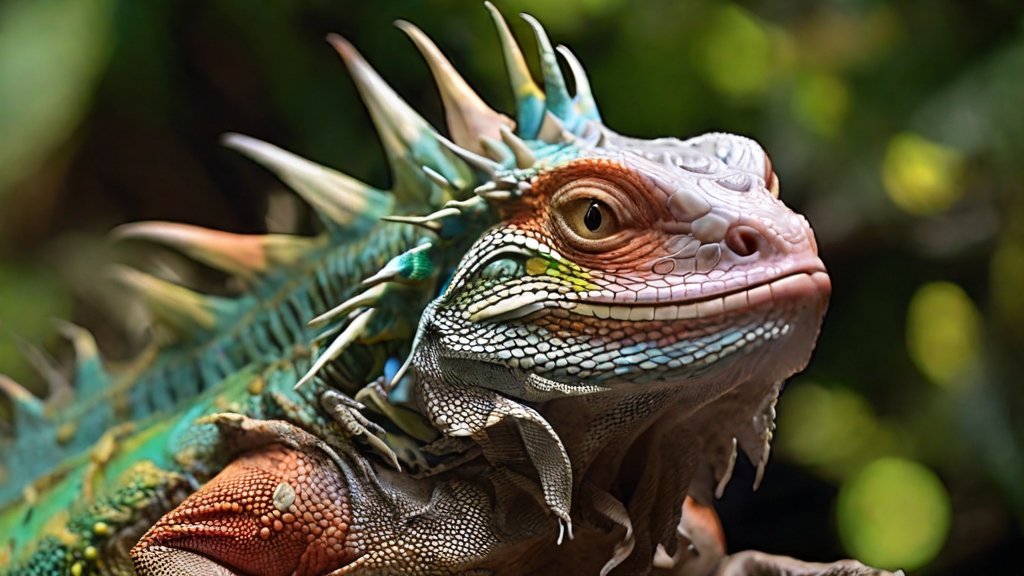Iguanas are one of the most popular reptiles kept as pets, but many people wonder if there is any difference in the coloration of male and female iguanas.
In this article, we will explore the question, “Are male iguanas more colorful?” by examining the differences in coloration between male and female iguanas, the reasons behind these differences, and how they relate to the behavior and health of these reptiles.
Iguanas – A Brief Overview
Iguanas are a type of lizard that belong to the family Iguanidae. They are native to tropical and subtropical regions of Central and South America, and the Caribbean.
Iguanas are herbivorous and primarily eat leaves, fruits, and flowers. They are known for their distinctive appearance, with long tails, sharp claws, and crests of skin running along their backs.
Iguanas are also popular pets, particularly the green iguana, which is one of the most common species kept in captivity. However, keeping iguanas as pets requires a significant amount of knowledge and care to ensure they are healthy and happy.
Differences in Coloration Between Male and Female Iguanas
Male Iguanas
Male iguanas are typically more colorful than females, with brighter hues and bolder patterns. This is particularly true during the breeding season when males become more vibrant in color to attract females.
Male iguanas can display shades of green, blue, orange, and red, depending on the species and individual.
Female Iguanas
Female iguanas are usually less colorful than males, with duller hues and less defined patterns. However, this is not always the case, as some female iguanas can also display bright colors and patterns. Additionally, female iguanas have smaller crests on their backs than males.
Reasons for Differences in Coloration
Sexual Selection
One reason for the differences in coloration between male and female iguanas is sexual selection. Male iguanas use their colorful displays to attract females during the breeding season.
The more vibrant and impressive the male’s coloration, the more likely he is to be chosen as a mate. This means that males with brighter colors and patterns are more successful in reproducing than those with duller coloration.
Thermoregulation
Another reason for the differences in coloration between male and female iguanas is thermoregulation. Iguanas are cold-blooded, which means they rely on external heat sources to regulate their body temperature. Bright colors can help males absorb more heat from the sun, making them more efficient at thermoregulation.
The Relationship Between Coloration and Behavior/Health
Sexual Selection and Aggression
The vibrant coloration of male iguanas not only attracts females but also serves as a warning to other males.
During the breeding season, males can become aggressive towards each other as they compete for mates. Bright colors can signal to other males that they should back off and avoid a fight.
Health Indicators
Coloration can also be an indicator of the health and well-being of iguanas. Bright and vibrant colors in male iguanas can suggest that they are healthy and have a good diet.
Conversely, dull colors or a lack of vibrancy can indicate poor health, malnutrition, or other health problems.
Female iguanas can also display certain color patterns that indicate their reproductive health. For example, female iguanas with bright orange or yellow patches on their throats and chests may be more fertile and capable of producing healthy eggs.
Conclusion
In conclusion, male iguanas are generally more colorful than females, and there are several reasons for this difference.
Bright colors help male iguanas attract mates and thermoregulate, while duller colors may suggest poor health. Female iguanas can also display bright colors, and these colors can indicate their reproductive health.
If you are considering keeping an iguana as a pet, it is essential to understand these differences and provide the necessary care to ensure your iguana’s health and happiness.
FAQs
- Do all male iguanas have brighter colors than females?
- Generally, yes, but some female iguanas can also display bright colors.
- Can an iguana’s color change over time?
- Yes, an iguana’s color can change depending on their age, health, and environment.
- What should I do if my iguana’s color is dull or fading?
- If your iguana’s color is dull or fading, it may indicate a health problem, and you should take them to a veterinarian.
- Can I tell the gender of my iguana by its color?
- No, the color of an iguana does not determine its gender. Other physical characteristics, such as the size of the crest on their back, are more reliable indicators.
- Are iguanas easy to take care of as pets?
- No, iguanas require a lot of care and specialized knowledge to keep them healthy and happy. If you are considering keeping an iguana as a pet, be sure to research their care requirements thoroughly.




